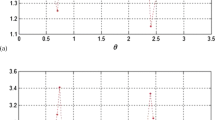Abstract
Certain aspects of classical and quantum mechanics of complex Hamiltonian systems in one dimension investigated within the framework of an extended complex phase space approach, characterized by the transformation x = x 1 + ip 2, p = p 1 + ix 2, are revisited. It is argued that Carl Bender inducted \( \mathcal{P}\mathcal{T} \) symmetry in the studies of complex power potentials as a particular case of the present general framework in which two additional degrees of freedom are produced by extending each coordinate and momentum into complex planes. With a view to account for the subjective component of physical reality inherent in the collected data, e.g., using a Chevreul (hand-held) pendulum, a generalization of the Hamilton’s principle of least action is suggested.
Similar content being viewed by others
References
For a Review on \( \mathcal{P}\mathcal{T} \)-symmetric Hamiltonians see, for example, C M Bender, Rep. Prog. Phys. 70, 947 (2007) and the references therein
C M Bender, Contemp. Phys. 46, 277 (2005) and the references therein
H Feshbach, C E Porter and V F Weisskopf, Phys. Rev. 96, 488 (1954)
See, for example, R K Colegrave, P Croxson and M A Mannan, Phys. Lett. A131, 407 (1988)
N N Rao, B Buti and S B Khadkikar, Pramana — J. Phys. 27, 497 (1986)
B Buti, N N Rao and S B Khadkikar, Phys. Scr. 34, 729 (1986)
C-D Yang, Chaos, Solitons and Fractals 33, 1073 (2007)
A L Xavier and M A M Aguiar, Ann. Phys. (N.Y.) 252, 45 (1996)
R S Kaushal and H J Korsch, Phys. Lett. A276, 47 (2000)
R S Kaushal and Shweta Singh, Ann. Phys. (N.Y.) 288, 253 (2001)
Shweta Singh and R S Kaushal, Phys. Scr. 67, 181 (2003)
R S Kaushal, J. Phys. A: Math. Gen. 34, L709 (2001)
R S Kaushal and Parthasarathi, J. Phys. A: Math. Gen. 35, 8743 (2002)
Parthasarathi and R S Kaushal, Phys. Scr. 68, 115 (2003)
Parthasarathi, D Parashar and R S Kaushal, J. Phys. A: Math. Gen. 37, 781 (2004)
C M Bender and S Boettcher, Phys. Rev. Lett. 80, 5243 (1998)
C M Bender, S Boettcher and P N Meissinger, J. Math. Phys. 40, 2201 (1999)
A Mustafazadeh, J. Math. Phys. 43, 205; 2814 (2002)
Parthasarathi, A study of complex phase space approach to quantum mechanics and supersymmetric quantum mechanics, Ph.D. Thesis (University of Delhi, 2004) (Unpublished)
F Cannata, M Ioffe, R Roy Choudhury and P Roy, Phys. Lett. A281, 305 (2001)
Ram Mehar Singh, Fakir Chand and S C Mishra, Pramana — J. Phys. 72, 647 (2009)
E Chevreul, Lettre’ A M Ampere’, ’sur ume classe particuliere de mouvemens muscularies’, Revue des Deus Mondes 2, 249 (1833)
M E Ansfield and D M Wegner, The feeling of doing, in: The psychology of action: Linking cognition and motivation to behaviour edited by P M Gollwitzer and J A Bargh (Guilford Publication Press, N.Y., 1996) Ch. 21
H H Spitz and Y Marcuard, Chevreul’s report on the mysterious oscillations of the hand-held pendulum: A French Chemist’s 1833 Open Letter to Ampere (Translation from French), Skeptical Inquirer 25, 35 (2001), No. 4. This is the magazine for Science and Reason published by the International Organization, ‘Committee for Scientific Investigations of Claim of the Paranormal’ (CSICOP)
R S Kaushal, Indian Phil. Quarterly (Poona) 29, 65 (2002)
A Raymond Penner, Rep. Prog. Phys. 66, 131 (2003)
Note that the realization of an object by a conscious person is not instantaneous. It rather takes a fraction of second before the person finally realizes the object and during this time not only the physiological processes continue inside the body but his consciousness also evolves to become appropriately intense.
J E Carroll, Euro. J. Phys. 28, 1151 (2007)
Radhey Shyam Kaushal, Ganita Bharati 30(1), 99 (2008)
See, for example, H Goldstein, Classical mechanics (Addison-Wesley Publishing Co., 1981) Ch. 2
V S Vladimirov, Methods of the theory of functions of many complex variables (MIT Press, Cambridge, MA, 1966)
Radhey Shyam Kaushal, The science of philosophy, Theory of fundamental processes in humamn behaviour and experiences (to be published by D.K. Print World (P) Ltd., New Delhi)
See, for example, R Ramanathan, Quantum mechanics of open systems as a stochastic process, in: Stochastic processes and their applications edited by A Vijay Kumar and M Sreenivasan (Narosa Pub. House, New Delhi, 1999) p. 317
Author information
Authors and Affiliations
Corresponding author
Rights and permissions
About this article
Cite this article
Kaushal, R.S. Classical and quantum mechanics of complex hamiltonian systems: An extended complex phase space approach. Pramana - J Phys 73, 287–297 (2009). https://doi.org/10.1007/s12043-009-0120-x
Published:
Issue Date:
DOI: https://doi.org/10.1007/s12043-009-0120-x



